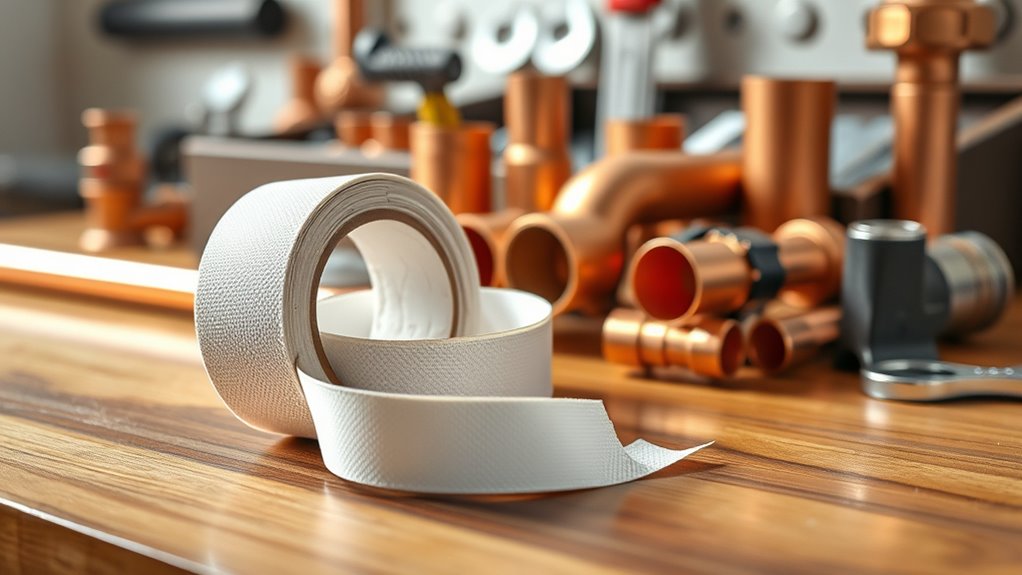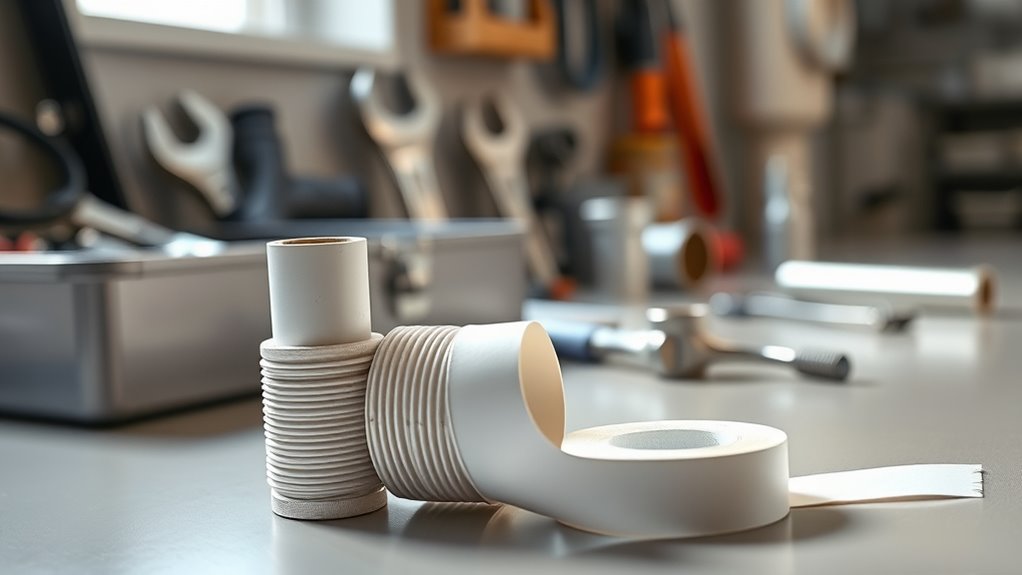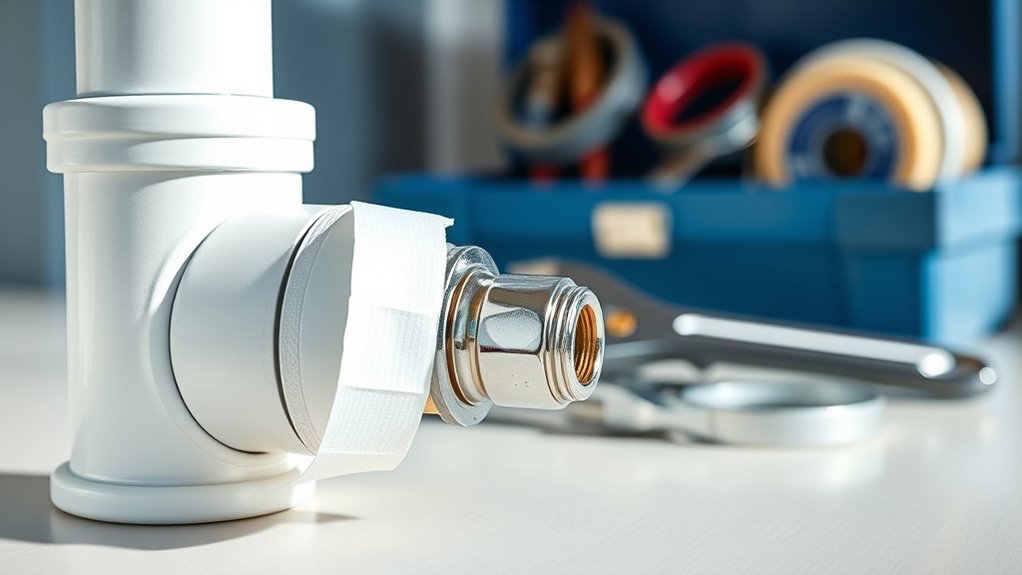How to Apply Pipe Tape Properly for Leak-Free Plumbing Connections
To apply pipe tape properly for leak-free plumbing connections, start by selecting the appropriate type of tape based on your specific application. Clean the pipe threads thoroughly to remove any debris or residue. Wrap the tape clockwise around the threads, using 2 to 3 layers for medium-sized fittings, guaranteeing slight overlaps without excessive bulk. Trim any excess tape to prevent obstruction. This method guarantees a secure fit, leading to effective sealing. Additional tips for success can further enhance your plumbing efforts.
Understanding Pipe Tape and Its Purpose

Pipe tape, also known as Teflon tape, serves a critical role in plumbing and piping applications. This thin, flexible tape is designed to create a seal between threaded connections, preventing leaks and ensuring a secure fit.
Its primary purpose is to reduce friction between the threads, facilitating easier assembly and disassembly of pipes. By filling in gaps and imperfections in the threaded surfaces, it enhances the overall integrity of the connection. This is especially important in high-pressure systems, where even minor leaks can lead to significant problems.
In addition, pipe tape is chemically resistant, making it suitable for various fluids, including water, gas, and oil. Understanding its purpose is essential for achieving reliable and long-lasting plumbing connections.
Types of Pipe Tape Available
While various types of tape exist for different applications, not all are suitable for plumbing purposes. The most common types of pipe tape include Teflon tape, thread sealant tape, and PTFE tape. Each type has distinct properties that cater to specific plumbing needs, ensuring secure and leak-free connections.
| Type of Tape | Material | Best Use |
|---|---|---|
| Teflon Tape | PTFE | General plumbing |
| Thread Sealant Tape | Rubber-based | High-pressure systems |
| PTFE Tape | Polytetrafluoroethylene | Water lines and fittings |
| Silicone Tape | Silicone | Temporary repairs |
| Plumber’s Putty | Non-hardening | Drain fittings |
Understanding these options assists in selecting the appropriate tape for different plumbing tasks.
Choosing the Right Pipe Tape for Your Needs
Selecting the appropriate pipe tape is essential for ensuring effective sealing in plumbing applications.
Factors such as the type of pipe tape, the materials involved, and the importance of tape thickness all play significant roles in achieving best results.
Understanding these considerations can help individuals make informed choices tailored to their specific needs.
Types of Pipe Tape
Choosing the right type of tape for plumbing applications is essential for ensuring leak-free connections. Several types of pipe tape are available, each suited for different plumbing needs. The most common types include PTFE tape, which is ideal for threaded connections, and silicone tape, known for its durability and flexibility.
| Type of Pipe Tape | Best Use |
|---|---|
| PTFE Tape | Threaded metal connections |
| Silicone Tape | Flexible and irregular shapes |
| Thread Sealant | Permanent, high-pressure joints |
Understanding these options allows plumbers and DIY enthusiasts to select the most suitable tape, promoting effective sealing and minimizing leakage risks in various plumbing projects. Choosing wisely can greatly impact the longevity and safety of plumbing systems.
Material Considerations
Understanding the specific material properties of pipe tape is crucial for making informed choices in plumbing applications.
Different types of pipe tape are designed for varying materials and environments. For instance, Teflon tape, composed of polytetrafluoroethylene, is commonly used for water and gas lines due to its chemical resistance and durability.
Conversely, silicone-based tapes offer high-temperature resistance, making them suitable for heated systems. Additionally, some tapes are formulated to be thicker or denser, providing enhanced sealing capabilities for larger gaps.
It is essential to evaluate compatibility with the pipe material, such as metal or PVC, to guarantee peak performance. Ultimately, selecting the right tape based on material properties will greatly influence the effectiveness of plumbing connections.
Tape Thickness Importance
Tape thickness plays a critical role in achieving effective seals in plumbing applications. Thicker tape generally provides a more robust barrier against leaks, making it suitable for larger fittings and high-pressure systems.
Conversely, thinner tape may be preferred for smaller connections, where excessive thickness can hinder proper tightening and create gaps. Selecting the appropriate tape thickness depends on the specific plumbing scenario, including pipe size and type of joint.
Additionally, thicker tape can often compensate for minor imperfections in the threads, enhancing the overall seal quality. As a result, understanding the requirements of each application guarantees that the right tape thickness is chosen, ultimately leading to better long-term performance and reliability in plumbing connections.
Preparing the Pipe Surface
Preparing the pipe surface is a vital step before applying tape.
It involves thoroughly cleaning the pipe to remove any dirt, grease, or debris, as well as inspecting for any damage that could affect the seal.
Ensuring a clean and intact surface will promote better adhesion and prevent leaks.
Clean the Pipe Thoroughly
A thorough cleaning of the pipe surface is essential for effective tape application. Removing dirt, grease, and old tape guarantees better adhesion and a leak-free seal. To clean the pipe, one can use a wire brush or cloth, followed by a solvent to eliminate residues. Proper preparation strengthens the integrity of the connection.
Here’s a quick reference table for cleaning materials:
| Cleaning Material | Purpose | Recommended Use |
|---|---|---|
| Wire Brush | Scrubs off debris | For rough surfaces |
| Cloth | Wipes excess dirt | For final cleaning |
| Solvent | Dissolves grease | After scrubbing |
| Rags | Removes moisture | Before tape application |
Inspect for Damage
After cleaning the pipe thoroughly, the next step involves inspecting it for any signs of damage. This inspection is essential, as even minor imperfections can lead to leaks post-installation.
The individual should look for cracks, dents, or corrosion along the pipe’s surface. A visual examination can reveal issues that may not be immediately apparent. If any damage is detected, it is advisable to replace the affected section of the pipe to guarantee a secure and leak-free connection.
Additionally, sharp edges or rough spots should be smoothed out to facilitate better tape adhesion. By addressing these concerns before applying pipe tape, one can greatly enhance the effectiveness of the seal and prolong the lifespan of the plumbing connection.
How to Clean the Threads Before Application
Cleaning the threads of a pipe is essential for ensuring a proper seal when applying pipe tape. Any debris, old tape, or corrosion can compromise the effectiveness of the tape, leading to leaks.
To begin, one should use a wire brush or cloth to remove loose particles from the threads. For stubborn residue, a suitable solvent may be applied to dissolve any remaining grime.
It is vital to dry the threads thoroughly after cleaning, as moisture can interfere with tape adhesion. Inspecting the threads for any signs of damage or wear is also advisable, as this could affect the seal.
A clean, dry surface is the foundation for a successful application of pipe tape, ensuring the best performance in plumbing connections.
The Correct Way to Wrap Pipe Tape

When applying pipe tape, selecting the appropriate type is vital for ensuring a proper seal.
The wrapping technique also plays a significant role in achieving a leak-free connection.
Understanding both the right tape and the essential wrapping methods can enhance the effectiveness of the application.
Choosing the Right Tape
Choosing the right tape is essential for ensuring a leak-free seal in plumbing projects. Plumber’s tape, also known as Teflon tape, is specifically designed for threaded pipe connections.
It is important to select a tape that matches the pipe material and application type. For example, a thicker tape is often used for larger pipes, while a thinner tape suffices for smaller connections.
Additionally, there are different types of tape available, such as PTFE tape for water lines and gas-rated tape for gas connections. Evaluating the tape’s width and density can also influence its performance in sealing.
Ultimately, selecting the appropriate tape will enhance the reliability of plumbing installations and minimize the risk of leaks.
Wrapping Technique Essentials
Applying pipe tape correctly is crucial for creating a secure seal on threaded connections. To begin, individuals should verify the pipe threads are clean and free of debris.
Starting at the end of the pipe, they should wrap the tape clockwise, following the direction of the threads. This method prevents the tape from unraveling during installation. It is important to use two to three layers of tape, avoiding excessive wrapping that may hinder the fitting’s ability to tighten properly.
Each layer should overlap slightly, guaranteeing complete coverage without gaps. Finally, the tape should be trimmed to avoid excess material that could obstruct flow.
How Many Turns of Tape Are Necessary
Determining the right number of turns for pipe tape is essential for guaranteeing a proper seal. The number of turns can vary based on the size and type of the connection.
Generally, the following guidelines can be observed:
- 1 to 2 turns for smaller fittings (1/8 inch to 1/4 inch) to avoid over-wrapping.
- 2 to 3 turns for medium-sized fittings (3/8 inch to 3/4 inch) to achieve an effective seal without excess bulk.
- 3 to 4 turns for larger fittings (1 inch and above) to guarantee adequate coverage and sealing.
- Consider the material of the pipe; Teflon tape may require fewer turns on certain plastics compared to metal.
Adhering to these guidelines will enhance the integrity of plumbing connections and minimize leaks.
Avoiding Common Mistakes When Applying Tape
Many common mistakes can undermine the effectiveness of pipe tape. One frequent error is applying tape in the wrong direction, which can lead to unraveling. Overlapping tape too much can create bulk, preventing a proper seal, while insufficient coverage may leave gaps. Additionally, using the wrong type of tape for the specific application can compromise integrity.
| Mistake | Consequence |
|---|---|
| Wrong application direction | Tape unravels during installation |
| Excessive overlapping | Creates bulky seal |
| Insufficient coverage | Leaves gaps for leaks |
Being aware of these common pitfalls can help guarantee that pipe tape is applied correctly, resulting in leak-free plumbing connections.
Tips for Tightening Connections After Taping

Once pipe tape has been properly applied, it is essential to guarantee that connections are tightened effectively to achieve a leak-free seal. Following these tips can enhance the tightening process:
- Hand Tighten First: Begin by hand-tightening the connection until resistance is felt, ensuring the tape is compressed evenly.
- Use the Right Tool: Employ an appropriate wrench or pliers to avoid damaging the pipe or fittings while tightening.
- Follow Torque Specifications: Refer to the manufacturer’s guidelines for torque settings to avoid overtightening, which can lead to cracks.
- Check Alignment: Ensure that the pipes are aligned correctly before final tightening to prevent undue stress on the joints.
These practices will greatly increase the effectiveness of the seal and reduce the risk of leaks.
Testing for Leaks After Installation
After installation, it is essential to thoroughly test for leaks to confirm that the pipe connections are secure and functioning as intended.
The first step involves visually inspecting all joints and connections for any signs of moisture. Next, the system should be pressurized, typically by turning on the water supply. Observing the pressure gauge can help determine if there is a drop in pressure, indicating a potential leak.
Additionally, using a cloth or paper towel can aid in identifying small leaks; any dampness on the towel suggests a problem. If leaks are detected, promptly addressing them by tightening connections or reapplying pipe tape is vital.
Regular checks should become part of ongoing maintenance to confirm long-term leak prevention.
When to Replace Pipe Tape
Recognizing when to replace pipe tape is vital for maintaining effective seals in plumbing systems.
Signs of worn tape, such as fraying or discoloration, indicate the need for replacement, while regular maintenance schedules can help determine frequency.
Additionally, proper disposal methods should be considered to guarantee environmentally responsible practices.
Signs of Worn Tape
Pipe tape serves as an essential barrier against leaks, but over time, it can deteriorate and lose its effectiveness. Recognizing the signs of worn tape is important for maintaining leak-free plumbing connections.
Here are four indicators that it is time to replace the pipe tape:
- Fraying Edges: If the tape appears ragged or has loose strands, it can no longer provide a tight seal.
- Discoloration: Yellowing or fading indicates exposure to moisture or age, compromising its sealing ability.
- Cracking or Peeling: Visible cracks or peeling sections suggest the tape has lost its flexibility and is no longer effective.
- Persistent Leaks: If leaks continue after applying fresh tape, it may indicate that the tape has worn down and needs replacement.
Frequency of Replacement
Regularly evaluating and replacing pipe tape is essential for ensuring effective plumbing connections.
It is advisable to replace the tape whenever a connection is loosened or disassembled. If a plumbing joint begins to show signs of leakage or if the tape appears worn or damaged, prompt replacement is necessary to prevent further issues.
Additionally, it is prudent to inspect the tape every few years, even if no visible problems arise, as aging can lead to reduced effectiveness.
When working with different types of pipes or fittings, consider replacing the tape to maintain compatibility.
Ultimately, proactive replacement of pipe tape can considerably reduce the risk of leaks and prolong the life of plumbing systems.
Proper Disposal Methods
When replacing pipe tape, it is vital to take into account proper disposal methods to guarantee environmental safety and compliance with local regulations.
Disposing of old pipe tape incorrectly can contribute to pollution and harm wildlife. As a result, following the appropriate disposal methods is essential.
- Check Local Regulations: Research local waste disposal guidelines for hazardous materials.
- Separate Materials: If the tape contains any synthetic materials, keep it separate from regular waste.
- Recycling Options: Investigate if any local facilities accept synthetic tape for recycling.
- Landfill Disposal: If no alternatives exist, dispose of the tape in a designated landfill waste container.
Pipe Tape vs. Other Sealants
While pipe tape is a popular choice for sealing threaded connections, it is essential to contemplate how it compares to other sealants available in the market.
Pipe tape, made from Teflon, is specifically designed for threaded joints, providing a reliable seal without adding bulk. In contrast, liquid pipe sealants or pastes can fill gaps more effectively in uneven surfaces but may require curing time.
Additionally, some professionals prefer anaerobic sealants, which bond to the pipe surfaces and create a strong, permanent seal. However, these products can be more difficult to remove.
Ultimately, the choice between pipe tape and other sealants depends on the specific application, the type of materials used, and the desired longevity of the connection.
Safety Precautions When Working With Pipe Tape
Considering the specific applications for pipe tape in comparison to other sealants, it becomes important to recognize the safety precautions necessary when handling it. Proper safety measures guarantee effective and secure usage while minimizing risks.
- Wear Protective Gear: Safety goggles and gloves protect against irritation or injury from tape residue or sharp pipe edges.
- Ventilate the Area: Guarantee adequate airflow when working in enclosed spaces to avoid inhaling fumes from adhesives.
- Avoid Over-Tightening: Excessive pressure can damage pipes or connections, leading to leaks or breaks.
- Store Properly: Keep pipe tape in a cool, dry place, away from direct sunlight, to maintain its integrity and effectiveness.
Troubleshooting Common Issues With Pipe Tape
Numerous issues can arise when using pipe tape, often stemming from improper application or environmental factors.
One common problem is leaks, which may occur if the tape is not wrapped tightly enough or if too little tape is used. Overlapping tape can also lead to leaks, as it may create uneven thickness.
Another issue is tape degradation, which can result from exposure to extreme temperatures or chemicals, compromising its sealing ability.
Additionally, using the wrong type of tape for specific materials, such as applying plumbing tape on gas lines, can lead to safety hazards.
Addressing these problems involves ensuring correct application techniques and selecting the appropriate tape for the specific plumbing context.
Proper troubleshooting can enhance the effectiveness of pipe tape in creating leak-free connections.
Maintenance Tips for Leak-Free Plumbing Connections
How can homeowners guarantee their plumbing connections remain leak-free over time? Regular maintenance is essential for preventing leaks. By following these simple tips, homeowners can make certain their plumbing systems function effectively:
- Inspect Connections: Periodically check for signs of moisture around joints and fittings.
- Tighten Fittings: Verify connections are snug but not overtightened, as this can damage threads.
- Replace Worn Components: Regularly replace washers, O-rings, and seals that show signs of wear.
- Test Water Pressure: Maintain ideal water pressure to avoid undue stress on pipes and joints.
Implementing these practices can help mitigate leaks and extend the lifespan of plumbing connections, leading to a more reliable and efficient home plumbing system.
Conclusion
In summary, applying pipe tape correctly guarantees secure connections, prevents leaks, and promotes longevity in plumbing systems. By understanding the types of tape, preparing surfaces diligently, and following proper application techniques, plumbers can achieve reliable results. Just as a well-taped joint holds tight, so too does a commitment to quality craftsmanship yield lasting success. In plumbing, as in life, the attention to detail and the right choices lead to peace of mind and enduring satisfaction.





